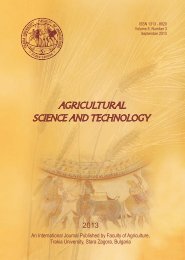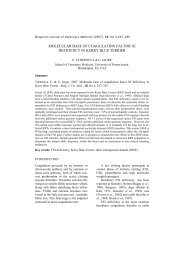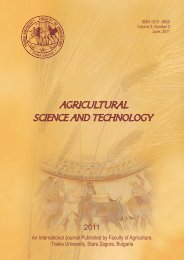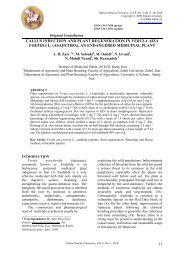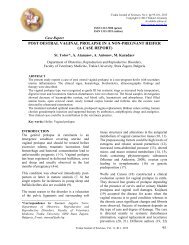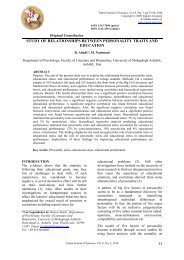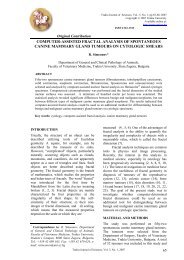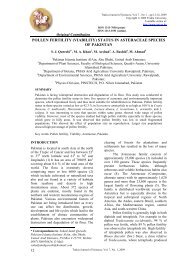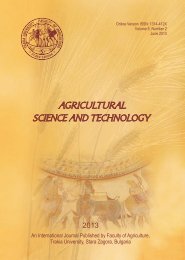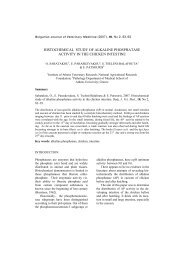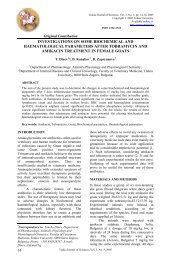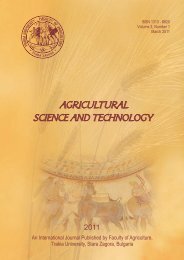amino acid and fatty acid content of yogurt supplemented with ...
amino acid and fatty acid content of yogurt supplemented with ...
amino acid and fatty acid content of yogurt supplemented with ...
Create successful ePaper yourself
Turn your PDF publications into a flip-book with our unique Google optimized e-Paper software.
10 years - ANNIVERSARY EDITION TRAKIA JOURNAL OF SCIENCESTrakia Journal <strong>of</strong> Sciences, Vol. 10, No 2, pp 17-25, 2012Copyright © 2012 Trakia UniversityAvailable online at:http://www.uni-sz.bgISSN 1313-7050 (print)ISSN 1313-3551 (online)Original ContributionAMINO ACID AND FATTY ACID CONTENT OF YOGURTSUPPLEMENTED WITH WALNUT AND HAZELNUT PIECESS. Boycheva 1 , G. Mihaylova 2 , N. Naydenova 2* , T. Dimitrov 21 Department <strong>of</strong> Biochemistry <strong>and</strong> Microbiology, Faculty <strong>of</strong> Agriculture, Trakia University,Stara Zagora, Bulgaria2 Department <strong>of</strong> Milk <strong>and</strong> milk products, Faculty <strong>of</strong> Agriculture, Trakia University,Stara Zagora, BulgariaABSTRACTAmino <strong>and</strong> <strong>fatty</strong> <strong>acid</strong> composition <strong>of</strong> cow’s milk <strong>yogurt</strong> <strong>with</strong> pieces <strong>of</strong> walnut (10%) <strong>and</strong> hazelnut(10%) added were investigated. The total amount <strong>of</strong> <strong>amino</strong> <strong>acid</strong>s in the <strong>yogurt</strong> <strong>with</strong> walnut pieces wasby 7.8% higher in comparison <strong>with</strong> raw milk <strong>and</strong> by 3.9% higher in comparison <strong>with</strong> natural <strong>yogurt</strong>.The amount <strong>of</strong> unsaturated <strong>fatty</strong> <strong>acid</strong>s in the <strong>yogurt</strong> <strong>with</strong> walnuts <strong>and</strong> hazelnuts was by 39% higher incomparison <strong>with</strong> natural <strong>yogurt</strong>. The amount <strong>of</strong> polyunsaturated <strong>fatty</strong> <strong>acid</strong>s in the <strong>yogurt</strong> <strong>with</strong> walnutpieces was almost three times higher in comparison <strong>with</strong> control <strong>yogurt</strong>.Key words: <strong>amino</strong> <strong>acid</strong>s, <strong>fatty</strong> <strong>acid</strong>s, cow’s milk, walnuts, hazelnuts, <strong>yogurt</strong>INTRODUCTIONYogurt is the most widely spread <strong>and</strong> mostfamous <strong>of</strong> all known dairy products inBulgaria. It takes an important role in the diet<strong>of</strong> the Bulgarian people <strong>with</strong> its nutritionalqualities. All <strong>of</strong> its components are combinedin an especially beneficial ratio, which canhardly be found in other food products.Yogurt is traditionally made from milk <strong>with</strong> noadded ingredients. To improve its texture <strong>and</strong>sensory properties <strong>yogurt</strong> is <strong>supplemented</strong> <strong>with</strong>other materials such as nonfat dry milk <strong>and</strong>other dairy or plant ingredients. The traditionalBulgarian <strong>yogurt</strong> can be added by herbalextracts, seeds <strong>and</strong> nuts <strong>with</strong> proven beneficialeffects on human health, which would enhanceits qualities (1, 2, 3, 4, 5).tissues from being harmed, which frequentlycause cancer <strong>and</strong> cardiovascular diseases (6).Another valuable component <strong>of</strong> nuts is folic<strong>acid</strong>, which is essential for cellular division<strong>and</strong> for the formation <strong>of</strong> red blood cells. Thereis an increased need for folic <strong>acid</strong> duringpregnancy, as it is vital for the proper growth<strong>of</strong> the foetus (7).Walnuts, combined <strong>with</strong> honey, arerecommended during recovery from severeillnesses, great physical or mental exhaustion,in cases <strong>of</strong> considerable weight loss, gastrointestinaldisorders (8), nervous <strong>and</strong>cardiovascular diseases, etc. (9, 10). Walnutshave a high nutritional value <strong>and</strong> high <strong>content</strong><strong>of</strong> polyunsaturated <strong>fatty</strong> <strong>acid</strong>s (11, 12).Nuts contain substantial amounts <strong>of</strong> vitamin E,which is, along <strong>with</strong> vitamin C, a strongantioxidant, i.e. it is involved in theneutralization <strong>of</strong> free radicals <strong>and</strong> thus protects___________________________________*Correspondence to: Nikolina Naydenova,Department <strong>of</strong> Milk <strong>and</strong> milk products, Faculty <strong>of</strong>Agriculture, Trakia University, Student town 6000,Stara Zagora, Bulgaria Tel.:+35942699354,fax: +35942670942,E-mail address:n_naidenova@uni-sz.bg10 years - ANNIVERSARY EDITIONTRAKIA JOURNAL OF SCIENCES, Vol. 10, No 2, 2012Hazelnuts have a significant role in humannutrition <strong>and</strong> health (13). They containsubstances, which seriously reduce the risk <strong>of</strong>cardiovascular diseases, some forms <strong>of</strong> cancer,as well as a number <strong>of</strong> physiologicalconditions <strong>and</strong> syndromes (14).In people who consume hazelnuts five or moretimes per week, the risk <strong>of</strong> cardiovascularillness is reduced by 50%, compared to thosewho do not consume hazelnuts (15). Similarresults have been reported in other studies (12,17
16, 27). This positive effect <strong>of</strong> hazelnuts isattributed to their <strong>fatty</strong> <strong>acid</strong> <strong>content</strong> (18).In the last years attempts have been made toimprove the quality, especially the healthbenefits <strong>of</strong> <strong>yogurt</strong>, but this needs to beinvestigated. Previous studies in our laboratoryon <strong>yogurt</strong>, <strong>supplemented</strong> <strong>with</strong> nuts showedpositive effect on quality characteristics <strong>of</strong><strong>yogurt</strong> <strong>and</strong> the microbial activity (19).The present study was designed to optimizeaddition <strong>of</strong> nut ingredients to produce <strong>yogurt</strong><strong>of</strong> the better quality as functional food. Theaim <strong>of</strong> this study was to estimate the <strong>amino</strong><strong>acid</strong> <strong>and</strong> <strong>fatty</strong> <strong>acid</strong> <strong>content</strong>s <strong>of</strong> <strong>yogurt</strong> fortified<strong>with</strong> addition <strong>of</strong> walnut <strong>and</strong> hazelnut pieces.MATERIAL AND METHODS1. Material1.1. Fresh milk <strong>and</strong> starter culturesFresh raw cow milk, obtained from local farmin Stara Zagora, <strong>and</strong> starter culture, containingStreptococcus thermophilus <strong>and</strong> Lactobacillusdelbrueckii ssp. bulgaricus (Lactina 17,produced by Bankya, Bulgaria) ready for directvat inoculation were used for <strong>yogurt</strong>preparation.The <strong>yogurt</strong> was prepared in laboratoryconditions.1.2. Yogurt preparationThe milk was pasteurized (95 °С/30 min),cooled to 45 °С <strong>and</strong> inoculated <strong>with</strong> 1.5%starter culture consisting <strong>of</strong> Lactobacillusdelbrueckii ssp. bulgaricus <strong>and</strong> Streptococcusthermophilus (Lactina 17, produced byBankya, Bulgaria). The raw milk (6 l) wasdivided into three lots – one control (natural)<strong>and</strong> two experimental. Prior to adding thestarter, 10 g kg -1 pieces (1-2 mm) from eitherwalnuts or hazelnuts was added toexperimental milk samples. The samples werethen cultivated at 42 °С until coagulation, thencooled <strong>and</strong> stored in a refrigerator at 4-6 °С.The experiment was repeated four times.2. MethodsThe samples were homogenized beforedetermination <strong>of</strong> <strong>amino</strong> <strong>and</strong> <strong>fatty</strong> <strong>acid</strong>s.2.1. Determination <strong>of</strong> <strong>amino</strong> <strong>acid</strong>Amino <strong>acid</strong>s were analyzed by technique <strong>of</strong>Moore <strong>and</strong> Stein using ion-exchangechromatography (20). The <strong>amino</strong> <strong>acid</strong>composition <strong>of</strong> raw milk <strong>and</strong> <strong>yogurt</strong>, bothBOYCHEVA S., et al.control <strong>and</strong> experimental, was determined byautomated <strong>amino</strong>analyzer “T 339M:”2.2. Determination <strong>of</strong> <strong>fatty</strong> <strong>acid</strong> compositionThe extraction <strong>of</strong> milk fat was done using themethod <strong>of</strong> Rose-Gottlieb using diethyl ether<strong>and</strong> petroleum ether (Methodenbuch, Bd. VIVDLUFA-Verlag, Darmstadt, 1985). After thatthe solvents were evaporated on a vacuumrotaryevaporator. For obtaining methyl esters<strong>of</strong> the <strong>fatty</strong> <strong>acid</strong>s, sodium methylate (CH 3 ONa)was used (21). The <strong>fatty</strong> <strong>acid</strong> composition <strong>of</strong>raw milk <strong>and</strong> <strong>yogurt</strong>, both control <strong>and</strong>experimental, was determined by gaschromatography “Pay-Unicam 304” <strong>with</strong> flameionization detector <strong>and</strong> column ЕС ТМ - WAX,30 m, ID 0.25 mm, Film:0,25 µm.The extraction <strong>of</strong> nuts fat was determinedusing the modified <strong>fatty</strong> <strong>acid</strong> methyl estermethod as described by Baydar et al. (1999)(22).3. Statistical analysisFor statistical analysis, ANOVA wasperformed on the three batches <strong>and</strong> thecorresponding replicates, using Statistica 8.0s<strong>of</strong>tware (StatS<strong>of</strong>t, Inc.,). Fisher test was usedfor means comparison.RESULTS AND DISCUSSION1. Amino <strong>acid</strong> <strong>content</strong> <strong>of</strong> <strong>yogurt</strong>During fermentation <strong>of</strong> milk, the <strong>amino</strong> <strong>acid</strong>pr<strong>of</strong>ile changed as a result <strong>of</strong> proteolyticactivity <strong>of</strong> lactic <strong>acid</strong> bacteria (Table 1). Thesame results are observed from other authors(23, 24, 25). It was interesting to note that anincrease in the total amount <strong>of</strong> <strong>amino</strong> <strong>acid</strong>scould be observed in the control sample whencompared to the raw cow’s milk.In both test samples, the total <strong>content</strong> <strong>of</strong> <strong>amino</strong><strong>acid</strong>s was higher compared to the controlsample. The increase was higher in the samplecontaining walnuts – by about 4%, followed bythe one containing hazelnuts – by 2.6%.The three branched-chain <strong>amino</strong> <strong>acid</strong> leucine,valine <strong>and</strong> isoleucine support numerousmetabolic processes ranging from thefundamental role as substrates for proteinsynthesis to metabolic roles as energysubstrates (26), precursors for synthesis <strong>of</strong>alanine <strong>and</strong> glutamine <strong>and</strong> as modulators <strong>of</strong>muscle protein synthesis (27).1810 years - ANNIVERSARY EDITIONTRAKIA JOURNAL OF SCIENCES, Vol. 10, No 2, 2012
Table1. Amino <strong>acid</strong> <strong>content</strong> <strong>of</strong> raw milk <strong>and</strong> <strong>yogurt</strong>, g/100 g sample, n=4<strong>yogurt</strong>BOYCHEVA S., et al.Amino <strong>acid</strong>sraw milk control <strong>with</strong> walnuts <strong>with</strong> hazelnutsx Sx x Sx x Sx x Sxaspartic <strong>acid</strong> 0.322 0.005 0.331 0.013 0.344 0.004 0.313 0.035threonine 0.143 0.007 0.143 0.005 0.144 0.003 0.137 0.007serine 0.141 0.002 0.139 0.004 0.145 0.003 0.135 0.013glutamic <strong>acid</strong> 0.855 0.032 0.895 0.020 0.945 0.020 0.934 0.052proline 0.340 0.002 0.354 0.007 0.354 0.009 0.352 0.014cysteine 0.034 0.004 0.038 0.009 0.048 0.009 0.066 0.014glycine 0.062 0.002 0.064a 0.003 0.076a 0.004 0.071 0.005alanine 0.114b 0.008 0.129a 0.003 0.140ab 0.003 0.144 0.008valine 0.238 0.005 0.258 0.006 0.255 0.006 0.251 0.005methionine 0.020 0.002 0.029 0.007 0.028 0.003 0.033 0.006isoleucine 0.189 0.008 0.196 0.009 0.198 0.004 0.190 0.008leucine 0.336 0.001 0.356 0.009 0.364 0.005 0.356 0.018tyrosine 0.147 0.003 0.144 0.007 0.140 0.007 0.140 0.005phenylalanine 0.167 0.001 0.180 0.007 0.193 0.012 0.196 0.015histidine 0.108 0.010 0.110 0.005 0.118 0.005 0.122 0.010lysine 0.276 0.008 0.286 0.011 0.273 0.006 0.271 0.008arginine 0.141 0.015 0.112a 0.009 0.148 0.016 0.153a 0.015Total 3.63 0.180 3.765 0.095 3.913 0.064 3.863 0.180Legend: a – p
Sulfur <strong>amino</strong> <strong>acid</strong>s <strong>and</strong> their metabolites are <strong>of</strong>major importance in health <strong>and</strong> disease.Methionine is classified as nutritionallyessential. Cysteine is classified as semiessential due to the variable capacity <strong>of</strong> bodyfor its production from methionine (28).Methionine, which has an effect on thefunctioning <strong>of</strong> the liver <strong>and</strong> the thyroid gl<strong>and</strong>,<strong>and</strong> is beneficial in cases <strong>of</strong> osteoporosis,varied from 0.55% in raw cow’s milk up to0.86% <strong>of</strong> the total <strong>amino</strong> <strong>acid</strong> <strong>content</strong> in <strong>yogurt</strong><strong>with</strong> hazelnuts.Cysteine <strong>content</strong> was higher in <strong>yogurt</strong>compared to raw milk, <strong>with</strong> the increase beingthe largest in the sample containing hazelnuts.Of the non-essential <strong>amino</strong> <strong>acid</strong>s, the highest<strong>content</strong> was that <strong>of</strong> glutamic <strong>acid</strong>, which isresponsible for protection from cardiovascularBOYCHEVA S., et al.diseases – <strong>with</strong> variations from 23.56% <strong>of</strong> thetotal amount <strong>of</strong> <strong>amino</strong> <strong>acid</strong>s in raw milk up to24.18% in the sample <strong>with</strong> hazelnuts, followedby proline. The differences between these two<strong>amino</strong> <strong>acid</strong>s were insignificant (p>0.05).Significant variations were observed in theamounts <strong>of</strong> the essential <strong>amino</strong> <strong>acid</strong>s glycine<strong>and</strong> alanine between control <strong>yogurt</strong> <strong>and</strong> <strong>yogurt</strong><strong>with</strong> walnuts (p
BOYCHEVA S., et al.Table 2. Fatty <strong>acid</strong> <strong>content</strong> <strong>of</strong> initial products, % , n=4Fatty <strong>acid</strong>s Raw milk Walnuts HazelnutsС 4:0 3.46 - -C 6:0 1.527 - -C 8:0 1.019 0.63 0.092C 10:0 2.549 0.155 -C 10:1 0.249 - -C 12:0 3.176 0.103 -C 12:1 0.072 - -C 12:2 0.061 - -C 13:0 0.082 - -C 14 i 0.155 - -C 14:0 11.538 0.406 0.196C 14:1 0.972 - -C 14:2 0.231 - -C15ai 0.535 - -C 15:0 0.944 0.064 -C 16 i 0.377 - -C 16:0 30.0 7.543 6.215C 16:1 0.184 0.059 0.15C16:2 1.631 0.112 -C 17:0 0.548 2.503 -C 17:1 0.269 - -C 18:0 9.253 2.987 -C 18:1 22.931 16.613 85.172C 18:2 4.155 57.18 7.819C 18:3 1.093 11.645 -C 20:0 0.267 - 0.356Saturated 68.152 14.391 6.859Unsaturated 31.848 85.609 93.141Mono-unsaturated 24.677 16.672 85.322Poly-unsaturated 7.171 68.937 7.819С18:2/С18:3 1.99 4.91 -PUSFA/SFA 0.10 4.79 1.14Unsaturated <strong>fatty</strong> <strong>acid</strong>s (USFA) play animportant role in human nutrition <strong>and</strong> health. The<strong>fatty</strong> <strong>acid</strong> pr<strong>of</strong>ile <strong>of</strong> nuts, high in unsaturated <strong>fatty</strong><strong>acid</strong>s such as oleic <strong>acid</strong> <strong>and</strong> low in saturated <strong>fatty</strong><strong>acid</strong>s, contributes to cholesterol lowering <strong>and</strong>hence coronary heart disease risk reduction byincreasing the high density lipoprotein (HDL) inblood (33, 34).The ratios <strong>of</strong> PUFA/SFA <strong>and</strong> USFA/SFA <strong>of</strong>hazelnuts <strong>and</strong> walnuts were found to be 1.14 v/s4.79 <strong>and</strong> 13.58 v/s 5.95 respectively. Theseresults were close to the ones found by Koksal etal. (2006) for hazelnuts <strong>and</strong> lower than those <strong>of</strong>Ozkan <strong>and</strong> Koyuncu (2005) for walnuts.Data on the <strong>fatty</strong> <strong>acid</strong> <strong>content</strong> <strong>of</strong> the milk fat inthe produced <strong>yogurt</strong> <strong>with</strong> walnut or hazelnutpieces added are presented in Table 3.10 years - ANNIVERSARY EDITIONTRAKIA JOURNAL OF SCIENCES, Vol. 10, No 2, 2012The <strong>fatty</strong> <strong>acid</strong> <strong>content</strong> <strong>of</strong> the control <strong>yogurt</strong>sample was similar to that <strong>of</strong> raw milk. In theexperimental samples, containing walnut <strong>and</strong>hazelnut pieces, the amounts <strong>of</strong> nearly allsaturated <strong>fatty</strong> <strong>acid</strong>s were lower than those in thecontrol sample (natural <strong>yogurt</strong>). The differencesbetween the control sample <strong>and</strong> the <strong>yogurt</strong> <strong>with</strong>added hazelnuts were significant <strong>with</strong> regard toС6:0 (р
BOYCHEVA S., et al.Table 3. Fatty <strong>acid</strong> <strong>content</strong> <strong>of</strong> <strong>yogurt</strong>, %, n=4Fatty <strong>acid</strong>sYogurtcontrol <strong>with</strong> walnuts <strong>with</strong> hazelnutsС4:0 2.037c 0.002 1.189cd 0.035 2.051d 0.046C 6:0 2.091a 0.118 1.647 0.467 1.508a 0.162C 8:0 1.364a 0.094 1.052 0.239 1.027a 0.084C 10:0 3.069a 0.178 2.406 0.355 2.429a 0.158C 10:1 0.302 0.019 0.238 0.044 0.247 0.019C 12:0 3.515a 0.258 2.791 0.295 2.806a 0.150C 12:1 0.075 0.014 0.101 0.061 0.112 0.051C 12:2 0.163 0.091 0.076 0.010 0.057 0.00C 13:0 0.090 0.008 0.092b 0.005 0.071b 0.002C 14 i 0.177 0.042 0.127 0.009 0.131 0.009C 14:0 11.849a 0.855 9.568 0.699 9.495a 0.537C 14:1 1.133 0.276 0.972 0.097 0.986 0.062C 15 i 0.224 0.014 0.191 0.028 0.320 0.069C15ai 0.543a 0.040 0.430 0.041 0.445a 0.014C 15:0 1.101 0.289 0.764 0.062 0.796 0.014C 16 i 0.389 0.049 0.283 0.015 0.296 0.027C 16:0 30.097a 1.538 25.734a 0.745 24.827a 1.640C 16:1 1.826c 0.180 0.405cd 0.041 0.152d 0.016C 17 i 0.509b 0.150 1.236b 0.057 1.404b 0.161C17 ai 2.353a 0.717 2.687b 0.553 0.241ab 0.171C 17:0 0.542b 0.217 0.333e 0.073 2.551be 0.511C 17:1 0.376c 0.021 0.329 0.126 0.540c 0.021C 18 i 0.200c 0.005 0.211d 0.010 0.129cd 0.011C 18:0 9.535 0.712 8.400 0.832 8.449 0.371C 18:1 21.401b 1.971 24.791 6.744 31.999b 1.526C 18:2 3.512 1.035 11.173 4.649 5.067 1.765C 18:3 2.356c 0.112 2.507d 0.153 1.514cd 0.116C 20:0 0.182 0.095 0.267 0.075 0.355 0.051С18:2/С18:3 1.49 - 4.46 - 3.35 -PUSFA/SFA 0.07 - 0.23 - 0.11 -Legend: a – p
BOYCHEVA S., et al.%short-chain medium-chain long-chain60,0050,0053,5054,9646,12 47,35 7,2645,2347,5140,0037,7037,1930,0020,0010,008,808,866,530,00raw milk control <strong>with</strong> walnuts <strong>with</strong> hazelnutsFigure 2. Content <strong>of</strong> short-, medium- <strong>and</strong> long-chain <strong>fatty</strong> <strong>acid</strong>s in raw milk <strong>and</strong> <strong>yogurt</strong>.During fermentation, the total amount <strong>of</strong>saturated <strong>fatty</strong> <strong>acid</strong>s decreased significantly inexperimental samples in comparison to rawmilk <strong>and</strong> control <strong>yogurt</strong> –by 13% <strong>and</strong> 15.15%for the samples containing walnuts <strong>and</strong>hazelnuts, respectively (Figure 3). Thetendency for unsaturated <strong>fatty</strong> <strong>acid</strong>s wasinverse. Their <strong>content</strong> was the lowest in control<strong>yogurt</strong> (<strong>with</strong>out additions) <strong>and</strong> higher in theexperimental samples. In the samplecontaining walnut pieces, the amount <strong>of</strong>unsaturated <strong>fatty</strong> <strong>acid</strong>s was increased the most– 35% compared to natural <strong>yogurt</strong>, nearly 28%compared to raw milk, <strong>and</strong> 27.69% comparedto the hazelnut-containing sample.%70,0060,0050,0040,0030,0020,0010,000,00saturated unsaturated68,15 69,8759,28 59,3340,73 40,6731,85 30,14raw milk control <strong>with</strong> walnuts <strong>with</strong> hazelnutsFigure 3. Content <strong>of</strong> the saturated <strong>and</strong> unsaturated <strong>fatty</strong> <strong>acid</strong>s in raw milk <strong>and</strong><strong>yogurt</strong> containing walnuts or hazelnuts.The <strong>content</strong> <strong>of</strong> monounsaturated <strong>fatty</strong> <strong>acid</strong>swas higher in the test samples, compared toboth raw milk <strong>and</strong> the control sample (Figure4). The greatest increase was observed for the<strong>yogurt</strong> <strong>with</strong> added hazelnuts – 43.75%compared to raw milk <strong>and</strong> 35.56% comparedto control <strong>yogurt</strong>. As a result <strong>of</strong> milk’scoagulation, the amounts <strong>of</strong> polyunsaturated<strong>fatty</strong> <strong>acid</strong>s (PUFA) in <strong>yogurt</strong> containing walnutpieces has increased 1.7 times compared to rawmilk <strong>and</strong> 2.7 times compared to control <strong>yogurt</strong>.10 years - ANNIVERSARY EDITIONTRAKIA JOURNAL OF SCIENCES, Vol. 10, No 2, 201223
BOYCHEVA S., et al.35%MUFAPUFA34,04302524,6825,1126,972015107,175,0313,766,6450raw milk control <strong>with</strong> walnuts <strong>with</strong> hazelnuts24Figure 4. Content <strong>of</strong> the mono- <strong>and</strong> polyunsaturated <strong>fatty</strong> <strong>acid</strong>s in raw milk <strong>and</strong><strong>yogurt</strong> containing walnuts or hazelnuts.The PUFA/SFA ratio was the lowest in natural<strong>yogurt</strong> – 0.07, followed by <strong>yogurt</strong> <strong>with</strong> hazelnuts– 0.11, <strong>and</strong> <strong>yogurt</strong> <strong>with</strong> walnuts – 0.23, which issignificantly lower than what was established forthe nuts.CONCLUSIONSThe addition <strong>of</strong> walnut pieces to <strong>yogurt</strong> increasedits total <strong>amino</strong> <strong>acid</strong>s <strong>content</strong> by 7.8% comparedto raw milk <strong>and</strong> by 3.9% compared to natural<strong>yogurt</strong>.The amount <strong>of</strong> unsaturated <strong>fatty</strong> <strong>acid</strong>s in <strong>yogurt</strong><strong>supplemented</strong> <strong>with</strong> walnut or hazelnut pieces wasby 35% higher than that in control <strong>yogurt</strong>. Theamounts <strong>of</strong> saturated <strong>fatty</strong> <strong>acid</strong>s were lower by15%.The amount <strong>of</strong> polyunsaturated <strong>fatty</strong> <strong>acid</strong>s in<strong>yogurt</strong> <strong>with</strong> added walnut pieces has increasednearly 3 times, compared to control <strong>yogurt</strong>.REFERENCES1. Boycheva, S., Dimitrov, T., Mihaylova, G. &Pavlov, D. Effects <strong>of</strong> some plantsupplements on the quality <strong>of</strong> <strong>fatty</strong> <strong>acid</strong> inBulgarian fermented milk. Food Science(Bg), 2, 2-6, 2007.2. Boycheva, S., Dimitrov, T., Mihaylova, G. &Naydenova, N. Amino<strong>acid</strong>s, <strong>fatty</strong> <strong>acid</strong>s <strong>and</strong>mineral composition <strong>of</strong> <strong>yogurt</strong> made fromcow`s <strong>and</strong> goat`s milk added <strong>with</strong> probioticbacteria. Food Science (Bg), 5, 39-41, 2007a.3. Damyanova, S., Vasileva, N., Todorova, S.,Stefanova, R. & Ganeva, E. Obtaining <strong>of</strong>functional food products. I. Yogurt byadding ground oat flakes. Scientific Works <strong>of</strong>the Rousse University, 48, 169-173, 2009.4. Dimitrov, T., Boycheva, S., Iliev, T. &Zheleva, N. Production <strong>of</strong> <strong>yogurt</strong> <strong>with</strong>10 years - ANNIVERSARY EDITIONTRAKIA JOURNAL OF SCIENCES, Vol. 10, No 2, 2012different additives. Animal Science (Bg), 4-5,41-44, 2002.5. Todorova, S., Damyanova, S., Vasileva, N.,Stefanova, R. & Ganeva, E. (). Obtaining <strong>of</strong>functional food products. I. Yogurt byadding sesame seeds. Scientific Works <strong>of</strong> theRousse University, 48 (9), 175-179, 2009.6. Giugliano D. Dietary antioxidants forcardiovascular prevention. Nutrition,Metabolism & Cardiovascular Diseases, 10,38-44, 2000.7. Wardlaw G. M., Perspectives in Nutrition,4th edition. Mc Graw-Hill, New York, pp A-56-A-57, 1999.8. Fukuda T., Ito H. & Yoshida T.Antioxidative polyphenols from walnuts.Phytochemistry, 63, 795-801, 2003.9. Abbey M., Noaks M., Belling G.B. & NestelP.J. Partial replacement <strong>of</strong> saturated <strong>fatty</strong><strong>acid</strong>s <strong>with</strong> almonds or walnuts lowers totalplasma cholesterol <strong>and</strong> low-densitylipoproteincholesterol. American Journal <strong>of</strong>Clinical Nutrition, 59, 995-999, 199410. Simopoulos A.P. Essential <strong>fatty</strong> <strong>acid</strong>s inhealth <strong>and</strong> chronic disease. AmericanJournal <strong>of</strong> Clinical Nutrition, 70 (3), 560s-569s, 1999.11. Exler J. & Weihrauch J.L. Provisional tableon the <strong>content</strong> <strong>of</strong> omega-3 <strong>fatty</strong> <strong>acid</strong>s <strong>and</strong>other fat components foods. Washington,DC: Department <strong>of</strong> Agriculture; PublicationHNIS/PT-103, 1986.12. Savage G.P. Chemical composition (Juglansregia L.) grown in New Zeal<strong>and</strong>. PlantFoods Human Nutrition, 60, 75-82, 2001.13. Ozdemir M., Ackurt F., Kaplan M., YildizM. & Loker M. Evaluation <strong>of</strong> new Turkishhybrid hazelnut (Corylus avellana L.)varieties: <strong>fatty</strong> <strong>acid</strong> composition, tocopherol
<strong>content</strong>, mineral composition <strong>and</strong> stability.Food Chemistry, 73, 411-415, 2001.14. Richardson D.G. The health benefits <strong>of</strong>eating hazelnuts: implications for blood lipidpr<strong>of</strong>iles, coronary heart disease, <strong>and</strong> cancerrisks. Acta Horticulturae (ISHS), 445, 295-300, 199715. Fraser G.E., Sabate J., Beeson W.L. &Strahan T.M.A. Possible protective effect <strong>of</strong>nut consumption on risk <strong>of</strong> coronary heartdisease. Archives <strong>of</strong> Internal Medicine, 152,1416-1424, 1992.16. Ebrahem K.S., Richardson D.G., TetleyR.M. & Mehlenbacher S.A. Oil <strong>content</strong>,<strong>fatty</strong> <strong>acid</strong> composition <strong>and</strong> vitamin Econcentration <strong>of</strong> 17 hazelnut varieties,compared to other types <strong>of</strong> nuts <strong>and</strong> oilsseeds. Acta Horticulture, 351, 685-692,1994.17. Koyuncu M.A., Koyuncu F., Bostan S. Z. &Islam A. Change <strong>of</strong> fat <strong>content</strong> <strong>and</strong> <strong>fatty</strong> <strong>acid</strong>composition during the fruit developmentperiod in the hazelnuts Tombul <strong>and</strong> Palazcultivars grown in Ordu. Acta Horticulturae,45, 229-233, 1997.18. Garcia J.M., Agar I.T. & Streif J. Lipidcharacteristics <strong>of</strong> kernels from differenthazelnut varieties, Turkish Journal <strong>of</strong>Agriculture <strong>and</strong> Forestry, 18, 199-202, 1994.19. Boycheva S., Naydenova N., Mihaylova G.,Dimitrov T. & Pavlov D. Qualitycharacteristics <strong>of</strong> <strong>yogurt</strong> <strong>supplemented</strong> <strong>with</strong>nuts. Agriculture Science <strong>and</strong> technolology,2(4), 57-63, 2010.20. Shin-Ichi Ishii. Ion-exchangechromatography <strong>of</strong> <strong>amino</strong> <strong>acid</strong>s <strong>and</strong>peptides. I. A new determination method <strong>of</strong>basic <strong>amino</strong> <strong>acid</strong>s on a carboxylic <strong>acid</strong> resin.The Journal <strong>of</strong> Biochemistry, 43(4), 531-537,195621. Jahreis G., J. Fritsche, M. SC. & HansSteinhart. Conjugated linoleic <strong>acid</strong> in milkfat: High variation depending on productionsystem, Nutrition Research, 17 (9), 1479-1484, 1997.22. Baydar, H., Marquard, R. & Turgut, I. Pureline selection for improved yield, oil <strong>content</strong><strong>and</strong> different <strong>fatty</strong> <strong>acid</strong> composition <strong>of</strong>sesame, Sesamum indicum. Plant Breeding118, 462-464, 199923. Abraham, A. G., Antoni, G. L. & Anon,MProteolytic activity <strong>of</strong> L. bulgaricus grownBOYCHEVA S., et al.in milk. Journal <strong>of</strong> Dairy Science, 76 (6),1498-1505, 1993.24. Giori, G. S., G.F. de Valdez, A.P. de RuizHolgado, & G. Oliver. Effect <strong>of</strong> pH <strong>and</strong>Temperature on the Proteolytic Activity <strong>of</strong>Lactic Acid Bacteria. Journal <strong>of</strong> DairyScience, 68 (9), 2160-2164, 1985.25. Rajagopal, S. N. & S<strong>and</strong>ine, W. E.Associative growth <strong>and</strong> proteolysis <strong>of</strong> Str.thermophilus <strong>and</strong> L. bulgaricus in skim milk.Journal <strong>of</strong> Dairy Science, 73(4), 894-899,1990.26. Harper, A. E., Miller, R. H. & Block, K. P.Branched-chain <strong>amino</strong> <strong>acid</strong> metabolism.Annual Review Nutrition,4, 409-454, 1984.27. Anthony, J. C., Anthony, T. G. Kimball, S.R. & Jefferson, L. S. Signaling pathwaysinvolved in translational control <strong>of</strong> proteinsynthesis in skeletal muscle by leucine.Journal <strong>of</strong> Nutrition, 131, 856-860, 2001.28. Grimble, R. F., The effects <strong>of</strong> sulfur <strong>amino</strong><strong>acid</strong> intake on immune function in humans,Journal <strong>of</strong> Nutrition, 166 (6), 1660S-1665S,2006.29. Mihaylova, G. Fatty <strong>acid</strong> composition <strong>and</strong>functional properties <strong>of</strong> the fat in milk <strong>and</strong>milk products from different agriculturalecosystems, Dissertation (DSN), Bulgaria,Stara Zagora, 2007.30. Peichevski I., Velev S. & Palaveeva Ts.Сomparative investigations on <strong>fatty</strong> <strong>acid</strong><strong>content</strong> <strong>of</strong> milk from Bulgarian Brwon,Samerican Brown <strong>and</strong> Holstein-Friesiancattle. Animal Science (S<strong>of</strong>ia), 20(3), 21-28,198331. Koksal, A. I., Artik, N, Simsek, A. & Gunes,N., Nutrient composition <strong>of</strong> hazelnut(Corylus avellana L.) varieties cultivated inTurkey. Food Chemistry, 99, 509-515, 200632. Ozkan, G. & Koyuncu, M. A., Physical <strong>and</strong>chemical composition <strong>of</strong> some walnut(Juglans regia L) genotypes grown inTurkey. Grasas y Aceitas, 56 (2), 141-146,2005.33. Alphan E., Pala M., Ackurt F., & Yilmaz T.Nutritional composition <strong>of</strong> hazelnuts <strong>and</strong> itseffects on glucose <strong>and</strong> lipid metabolism.Acta Horticulture (ISHS), 445, 305-310,1997.34. Etherton P. M. K., Zhao G., Binkoski A. E.,Coval S. M. & Etherton T. D. The effects <strong>of</strong>nuts on coronary heart disease risk.Nutritional Reviews, 59(4), 103-111, 2001.10 years - ANNIVERSARY EDITIONTRAKIA JOURNAL OF SCIENCES, Vol. 10, No 2, 201225



